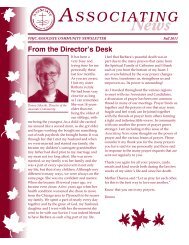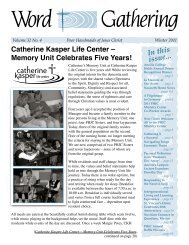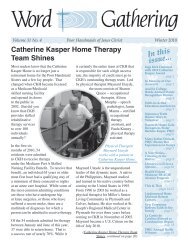Download the Spring edition of Word Gathering - Poor Handmaids ...
Download the Spring edition of Word Gathering - Poor Handmaids ...
Download the Spring edition of Word Gathering - Poor Handmaids ...
Create successful ePaper yourself
Turn your PDF publications into a flip-book with our unique Google optimized e-Paper software.
A Tale <strong>of</strong> Two Books<br />
Earthworks<br />
When I sat down to write a book review on “green<br />
living” for <strong>Word</strong> Ga<strong>the</strong>ring, I decided to consider two<br />
books: Living Green: A Practical Guide to Simple<br />
Sustainability by Greg Horn and Wake Up and Smell<br />
<strong>the</strong> Planet, edited by Brangien Davis and Katharine<br />
Wroth, <strong>of</strong> Grist.org. Having read both a while ago, I<br />
thought I would choose one for my review.<br />
I wanted to review a book that was practical,<br />
informative, non-frightening, and certainly not<br />
filled with <strong>the</strong> gloom and doom that has<br />
dominated <strong>the</strong> popular press lately. To<br />
prepare, I decided to re-read each <strong>of</strong><br />
<strong>the</strong>m. And only <strong>the</strong>n did I remember<br />
<strong>the</strong> big difference between <strong>the</strong>m.<br />
Horn’s book, Living Green, is<br />
filled with an enormous amount<br />
<strong>of</strong> factual information, ga<strong>the</strong>red,<br />
he tells us, as a result <strong>of</strong> his<br />
developing a case <strong>of</strong> “sick building<br />
syndrome” (also known as MCS,<br />
multiple chemical sensitivity). From this troubling<br />
health event, Horn went on to thoroughly investigate<br />
<strong>the</strong> sources <strong>of</strong> contamination in foods, cleaning and<br />
cosmetic products, and building supplies. He tells us<br />
that most people ask him “What can I do?” He <strong>of</strong>fers<br />
150 pages <strong>of</strong> answers, many <strong>of</strong> which recommend<br />
organic and safe name-brand products for <strong>the</strong> green<br />
consumer to search out.<br />
Horn’s book is divided into three sections, with callouts<br />
that describe personal stories or “heroes” <strong>of</strong><br />
<strong>the</strong> environment – individuals or corporations that<br />
are fostering change. The reader also finds helpful<br />
summaries entitled “What you need to know.”<br />
Consider <strong>the</strong> following Hero description:<br />
Seventh Generation is <strong>the</strong> leading brand <strong>of</strong> nontoxic<br />
cleaning supplies in <strong>the</strong> US, and its products<br />
avoid <strong>the</strong> hazardous ingredients mentioned above.<br />
They are <strong>the</strong> best company I have found for green<br />
cleaning products and natural personal care. (p.84)<br />
In spite <strong>of</strong> its green consumer suggestions, Horn’s<br />
revelations made me feel overwhelmed by all <strong>the</strong><br />
toxic chemicals lurking in my everyday life. I was<br />
also a bit put <strong>of</strong>f by <strong>the</strong> absence <strong>of</strong> simple solutions.<br />
For example, a recipe for a non-toxic house cleaning<br />
solution would have been really helpful. Instead,<br />
Horn gives a great deal <strong>of</strong> information about safe<br />
products I can buy.<br />
Wake up and Smell <strong>the</strong> Planet, on <strong>the</strong> o<strong>the</strong>r hand,<br />
contains just about <strong>the</strong> same information but<br />
presents it with humor, restraint, and<br />
compassion for <strong>the</strong> reader who might want<br />
to do something, but just not everything<br />
at once. The book is organized into<br />
sections that correspond to a working<br />
person’s day: so, for example, <strong>the</strong><br />
first chapter covers showering,<br />
breakfast (especially c<strong>of</strong>fee), and<br />
some thoughts about clothing.<br />
The following excerpt gives a good<br />
idea <strong>of</strong> <strong>the</strong> tone and type <strong>of</strong> helpful<br />
recommendations that Wake Up <strong>of</strong>fers.<br />
If you take <strong>the</strong> edge <strong>of</strong>f <strong>the</strong> day by knocking back<br />
a frosty beverage, spend a few moments between<br />
swigs to consider <strong>the</strong> container. The can versus<br />
bottle dilemma is a tricky one, but a good basic<br />
rule is to drink locally bottled beer in glass bottles<br />
if you can. (p.142)<br />
Or again:<br />
One way to <strong>of</strong>fset some <strong>of</strong> <strong>the</strong> high cost <strong>of</strong><br />
organics is to limit your spending on <strong>the</strong> produce<br />
most likely to be saturated in pesticides. Check<br />
out <strong>the</strong> Environmental Working Groups website<br />
(www.foodnews.org) to view a handy list ranking<br />
nonorganic produce by pesticide load. (p.132)<br />
The issue in both books is change – what in my life can<br />
I change in order to live more sustainably? Horn’s book<br />
reveals toxins in many unexpected places, and <strong>the</strong>n<br />
helps us to buy environmentally responsible products.<br />
Grist’s book tells us to review what we already have in<br />
our homes, to think about some <strong>of</strong> our behaviors, and<br />
only lastly to start buying different products. I found<br />
(A Tale <strong>of</strong> Two Books, continued on page 5)<br />
4 | <strong>Word</strong> Ga<strong>the</strong>ring












